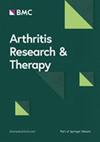Correlation of high-resolution computed tomography and immunological bronchoalveolar lavage in interstitial lung disease at the onset of inflammatory rheumatic diseases: implications for diagnosis and therapeutic strategies
IF 4.9
2区 医学
Q1 Medicine
引用次数: 0
Abstract
Inflammatory rheumatic diseases (IRD) are often associated with interstitial lung disease (ILD). The aim of the present study was to establish a correlation between the findings on HRCT and the immunological bronchoalveolar lavage (BAL). The study included 74 patients with newly diagnosed IRD and evidence of ILD on HRCT with the following pattern: ground-glass opacities (GGO), non-specific interstitial pneumonia (NSIP) and usual interstitial pneumonia (UIP). Patients with other HRCT pattern were excluded. No patient received any immunosuppressive therapy. In addition to HRCT, immunological BAL was performed and the American Thoracic Society clinical practice guideline were used to define BAL patterns (lymphocytic cellular pattern, neutrophilic cellular pattern, eosinophilic cellular pattern and unspecified pattern). The main HRCT patterns were NSIP (47.3%), GGO (33.8%), and UIP (18.9%). BAL patterns showed the following distribution: 41.9% lymphocytic cellular pattern, 23.0% neutrophilic cellular pattern, 18.9% eosinophilic cellular pattern, and 16.2% unspecific cellular pattern. Placing these data in the context of the HRCT findings, the lymphocytic cellular BAL pattern (48%) was most commonly BAL pattern associated with GGO pattern in HRCT, whereas neutrophilic and lymphocytic cellular BAL patterns were the dominant feature in NSIP and UIP. In patients with new-onset IRD and ILD, inflammatory pulmonary changes are predominate, reflected by GGO on HRCT and a mainly lymphocytic cell profile in the immunological BAL. In NSIP or UIP on HRCT, the percentages of lymphocytes and neutrophils were higher in BAL fluid, representing a fibrotic component in addition to the inflammation. Consequently, patients with evidence of GGO on HRCT should primarily be treated with anti-inflammatory/immunosuppressive therapy, whereas in patients with NSIP and UIP a combination of anti-inflammatory and anti-fibrotic agents would be the appropriate treatment.炎症性风湿病发病初期间质性肺病的高分辨率计算机断层扫描与免疫学支气管肺泡灌洗的相关性:对诊断和治疗策略的影响
炎症性风湿病(IRD)通常与间质性肺病(ILD)有关。本研究旨在确定 HRCT 和免疫学支气管肺泡灌洗(BAL)结果之间的相关性。研究纳入了 74 名新确诊的 IRD 患者,这些患者的 HRCT 表现为以下模式的 ILD:磨玻璃不透明(GGO)、非特异性间质性肺炎(NSIP)和常见间质性肺炎(UIP)。不包括其他 HRCT 模式的患者。没有患者接受任何免疫抑制治疗。除 HRCT 外,还进行了免疫学 BAL 分析,并根据美国胸科学会临床实践指南来定义 BAL 模式(淋巴细胞细胞模式、中性粒细胞模式、嗜酸性粒细胞模式和未指定模式)。主要的 HRCT 模式为 NSIP(47.3%)、GGO(33.8%)和 UIP(18.9%)。BAL 模式的分布如下41.9%为淋巴细胞型,23.0%为中性粒细胞型,18.9%为嗜酸性粒细胞型,16.2%为非特异性细胞型。将这些数据与 HRCT 结果结合起来看,在 HRCT 中,淋巴细胞细胞型 BAL(48%)是最常见的与 GGO 型相关的 BAL 型,而在 NSIP 和 UIP 中,中性粒细胞和淋巴细胞细胞型 BAL 是主要特征。在新发 IRD 和 ILD 患者中,肺部炎症性改变占主导地位,这反映在 HRCT 上的 GGO 和免疫学 BAL 中以淋巴细胞为主的细胞特征。在 HRCT 上显示为 NSIP 或 UIP 的患者,其 BAL 液中淋巴细胞和中性粒细胞的百分比较高,这表明除炎症外还有纤维化成分。因此,在 HRCT 上有证据显示 GGO 的患者应主要接受抗炎/免疫抑制治疗,而对于 NSIP 和 UIP 患者,抗炎药物和抗纤维化药物的联合使用将是适当的治疗方法。
本文章由计算机程序翻译,如有差异,请以英文原文为准。
求助全文
约1分钟内获得全文
求助全文
来源期刊

Arthritis Research & Therapy
RHEUMATOLOGY-
CiteScore
8.60
自引率
2.00%
发文量
261
审稿时长
14 weeks
期刊介绍:
Established in 1999, Arthritis Research and Therapy is an international, open access, peer-reviewed journal, publishing original articles in the area of musculoskeletal research and therapy as well as, reviews, commentaries and reports. A major focus of the journal is on the immunologic processes leading to inflammation, damage and repair as they relate to autoimmune rheumatic and musculoskeletal conditions, and which inform the translation of this knowledge into advances in clinical care. Original basic, translational and clinical research is considered for publication along with results of early and late phase therapeutic trials, especially as they pertain to the underpinning science that informs clinical observations in interventional studies.
 求助内容:
求助内容: 应助结果提醒方式:
应助结果提醒方式:


